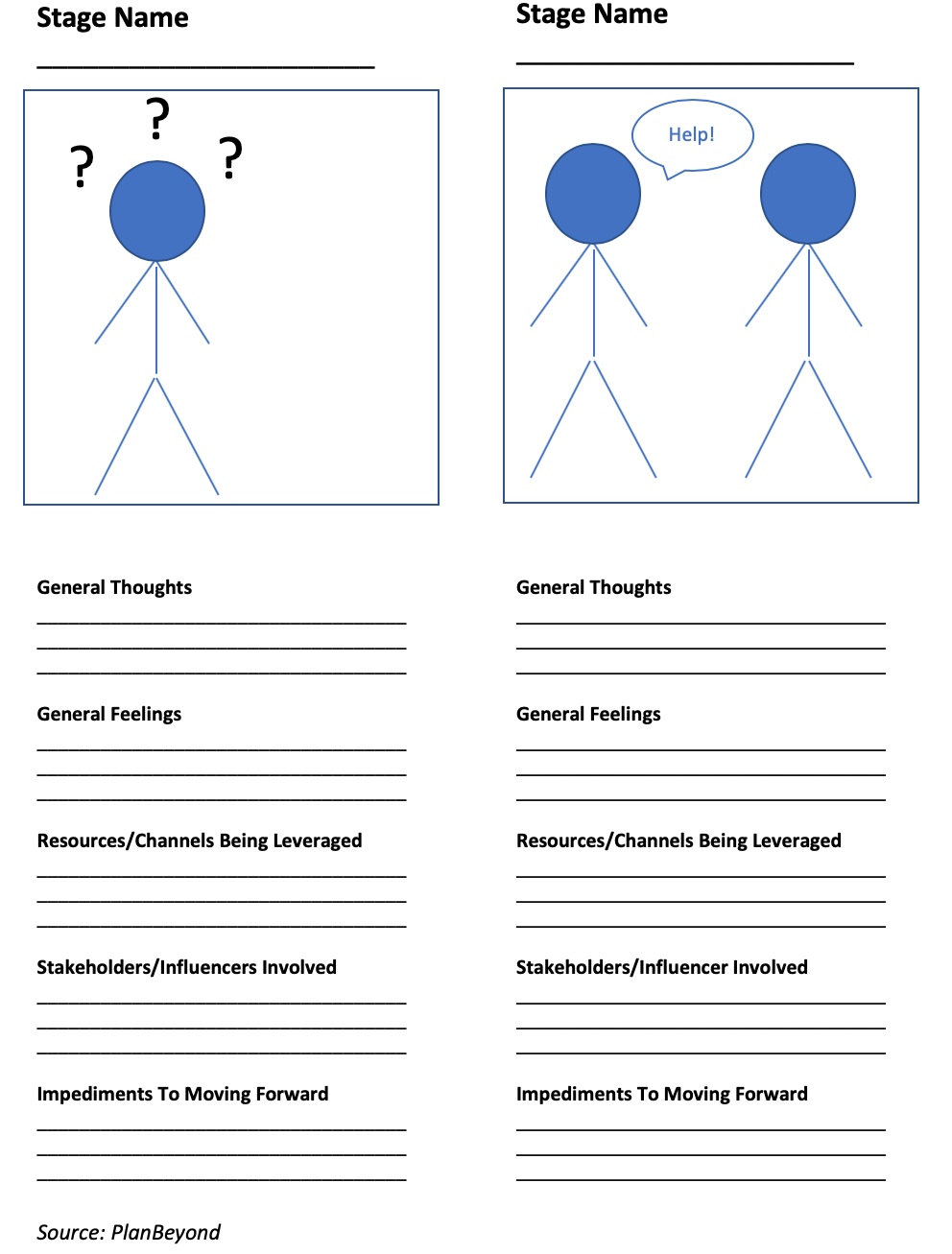No matter whether you’re talking marketing, sales, or product development, the customer experience should always be front and center. After all, how else will you know how to attract a prospect, gain their trust, convince them to buy, or build a product that will wow them if you don’t know what it is they need and the problem they’re trying to solve?
One core tool to do this is a customer journey map. By allowing anyone within an organization to visualize the customer or buyer journey, and the different components that exist within discrete journey steps, customer journey maps are powerful resources for orienting teams around how best to address customer challenges.
What Is A Customer Journey Map
A customer journey map is a visual representation of the steps a prospective customer will experience as they interact with your business and make a purchase. It helps you keep the customer experience front-and-center as you think about the stages they go through to evaluate and consider what you have to offer.
At first glance, this sounds extremely simple. You can easily map out the path the purchase, right? But once you start to get into the weeds of customer experiences, customer journeys can get very complex. Unique customer needs can impact how they find your business in the first place, not to mention how they evaluate your product against their needs. The same can be true for how they first heard about your product. A prospect hearing about you from a friend may consider you in a different way than someone that first hears about you from a trade publication. Creating customer journeys that account for these diverse needs and touch points gives you the opportunity to optimize the experience at each stage in the conversion process.
Why Are Customer Journey Maps Important
It’s typical to say to yourself, “I already know my customer really well. I don’t need to jot down how they’re engaging with us.†While this may be true at a surface level, you’ll find that breaking down each step in the journey a customer takes to not just find your business but also purchase your product will allow you to optimize each step to improve customer satisfaction and conversions as a whole.
-
Bring Objectivity To Your Customer Experience: Whoever “owns†the customer experience in an organization is inclined to think it’s great. While it might be good, there are always opportunities for improvement. Building customer journey maps helps bring an objective, documented lens to the customer experience so that everyone can visualize the process, the inherent challenges in the journey to overcome, and the places where the journey is still less-than-ideal.
-
Isolate Misalignments Between the Ideal & Actual Experience: Taking a step-by-step approach to review each stage in the journey lets you zero-in on places where the customer is having an inferior experience. There may be places where it’s natural for customers to have questions…but there’s no collateral available to answer them well. Or, it may be that customers are expected to complete a process online…but the process isn’t intuitive. Finding these misalignments are an ideal way to shore up places in your funnel where you’re likely churning prospective customers.
-
Pinpoint Areas With The Greatest Improvement Opportunities: With those misalignments identified, you can begin to prioritize the lowest-hanging opportunities. Sometimes it’s early in the buyer’s journey, sometimes it’s later. The journey map is a great tool to isolate the weakest areas so you can start there.
-
Isolate Ideal Customer Segments: One offshoot of the customer journey mapping process is mapping the buying process by the unique customer segments you serve. The process of doing so will often help identify segments who you can serve extremely well today (perhaps because they need little education or their need is so great) versus those less-well served. It can help you decide if you want to double-down on one particular segment or if you’re ready to broaden your scope to access new segments.
The Different Types of Customer Journey Maps
While customer journey maps show a customer moving through a particular process, your map can focus on different aspects of the experience. That’s why you’ll first have to determine what kind of journey map you want to build out.
Current State Journey This is probably the most common type of customer journey map, and it visualizes what your customers do, think, and ask as they engage with your business in its current state. This approach generally helps isolate incremental opportunities to improve the customer experience by highlighting existing pain points customers experience and how you do and don’t address them today.
Day In The Life Journey This type of journey visualizes what people do, think, and ask as they consider a need or challenge they’re aiming to address. Notably, this is independent of whether or not they’re engaging with your organization or not. Because it takes a much broader view of prospect interactions and behaviors, it helps isolate larger pain points and drive to wider-reaching innovations and improvements.
Ideal State Journey Generally seen as a journey that will happen in the future, this journey map visualizes how customers will interact with your business somewhere down the road. Because it maps out an ideal journey, it helps illustrate your goal for how your overall experience (e.g. marketing, sales, product, etc.) will align with customer needs.
Service Blueprint Journey Unlike the previous journeys we just described, service blueprints take a more behind-the-scenes approach to mapping. They often start with a Current State or Day In the Life Journey, and then map out they systems, processes, tools, etc. that must happen at each stage in that journey to deliver the desired customer experience. When mapped to your existing customer journeys, they can help isolate incremental resources you’ll need to deliver the right experience. When mapped to more future-oriented journey’s, they’ll help you identify the full breadth of tools and resources you’ll need to deliver on the desired experience.
Building A Customer Journey Map
There is no single one way to build a customer journey map. However, you’ll find some general features almost always included across most maps, which we’ve marked up in the example we’ve included below.

-
Designate Discrete Stages: First things first, you’ll want to identify the discrete steps or stages in your customer journey. Give them a name so you can make sure you’re isolating truly unique steps in the customer experience process.
-
Illustrate The Experience: For each stage, include a simple drawing of what the customer is going through. Don’t worry, simple stick figures will suffice. This piece is less about showcasing your artistic talents and more about beginning to visually identify who your customer is, what environment they’re working in, and who else might be around them.
-
Jot Down General Thoughts & Feelings: Key to knowing how to engage with your customer is knowing exactly what’s going on in their head at any given stage. Give life to their thoughts, feelings and concerns by jotting them out by stage. This way, you’ll know both the reason and emotion you’ll have to address during the buyer journey.
-
Determine Resources Being Used: As your customer moves through their experience, do they turn to any resources or people to learn more? If so, you’ll want to include those so you’ll know how best to integrate those resources into their experience.
-
Isolate Stakeholders & Influencers: Very few decisions are done in a vacuum. If your customer has to bring others along for the purchase decisions, or has to influence the perceptions of people around them, that’s a critical burden to overcome. Including this in your customer journey mapping is key so you don’t forget about everyone else you have to contend with during the customer experience.
-
Identify Roadblocks & Impediments Throughout the customer experience, there are often issues that pop up that may turn a prospect away from purchasing. Once again, be upfront and record them. You can’t overcome barriers to purchase if you don’t acknowledge they exist!
To be crystal clear, none of these elements is necessarily set in stone. Complex products and services that require a lot of education and consideration will likely have many unique stages, many stakeholders, and tons of potential impediments. Simpler products will likely have fewer of all of these. Regardless, the name of the game with customer journey mapping is putting concrete customer thoughts, ideas, and concerns down on paper so you can begin reviewing them relative to the experience you’re offering today. This will let you isolate how you can materially improve the customer experience and drive new customer acquisition.
Use Customer Journey Maps To Benchmark Your Company Values
One last takeaway we’ll leave you with is that journey maps are also a strong way to prove that you’re living up to your company values (or, if you’re falling short). Many organizations have mission and values statements that put black and white terms around their service caliber and customer commitment. However, they’re infrequently asked to prove they live these values out to their fullest.
Mapping your customers’ journeys lets you do just that. It offers clear insight into where your organization lives up to its brand promises and where there’s opportunity for improvement.





